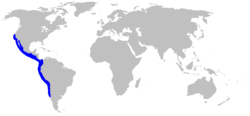Swellshark
| Swellshark | |
|---|---|
 |
|
| Scientific classification | |
| Kingdom: | Animalia |
| Phylum: | Chordata |
| Class: | Chondrichthyes |
| Subclass: | Elasmobranchii |
| Superorder: | Selachimorpha |
| Order: | Carcharhiniformes |
| Family: | Scyliorhinidae |
| Genus: | Cephaloscyllium |
| Species: | C. ventriosum |
| Binomial name | |
|
Cephaloscyllium ventriosum (Garman, 1880) |
|
 |
|
| Range of the swellshark (in blue) | |
The swellshark (Cephaloscyllium ventriosum) is a catshark of the family Scyliorhinidae. It is found in the subtropical eastern Pacific Ocean between latitudes 40° N and 37° S, from the surface to 460 m.
It grows to about 100 centimeters (39 in) in length, and can expand its body to about double its regular size to prevent its predators such as seals and larger sharks from pulling it out from rocky reefs, under ledges, and in crevices. The swellshark's appearance resembles that of the leopard shark in that it has spots. Younger swellsharks are lighter in color than the older ones. Swellsharks are nocturnal, sleeping in reef crevices and caves during the day. Sometimes, these sharks will grab onto their tail with their mouth in a ring shape to prevent other fish from being able to attack them. During the night they hunt molluscs, crustaceans and bony fishes. The swellshark is oviparous, and the females lay two flattened egg sacks which contain the embryo which is attached by two tendrils to a reef. Swellsharks are commonly found in aquariums and are completely harmless to humans, usually staying completely motionless when encountered by divers. The World Conservation Union has assessed this species as a least concern species worldwide, as it is usually not fished by divers and fishermen due to its poor flesh quality. However the occasional swellshark is killed by fishermen and this along with its low egg production may put the species at risk.
...
Wikipedia

